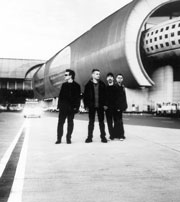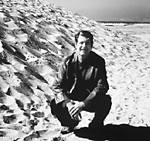Most of us have had an Eric Clapton in our lives. Even the weird evolution of his nicknames, from Loony to Slowhand, hints that it’s been a wild ride. Now 53 and festooned with more awards and medals than Marshal Zhukov, he lives in bucolic pomp in England. And while there’s no shortage of spurious “actress-models” in tow, Clapton remains a loner. Of his inability to settle down, he says, “It seems to be almost impossible for me to find myself in a relationship without wanting to run away and go and be a little kid again, and play the guitar and misbehave.”
Eric Clapton
Key Arena, Saturday, June 6
A whole dysfunctional-analysis PhD could be done on the artist formerly known as God, not least the early years. Clapton was dumped by his teenage mother, Pat, and raised by his grandparents. His mysterious father turns out to have been a Canadian soldier with a yen for sex, booze, and playing boogie-woogie piano. Eleven years later, Pat reappeared and was introduced to Eric as his big sister. That fiction lasted a week, until a knowing local daubed the Claptons’ front wall with graffiti: GET LOST PAT YOU SLUT.
At 15, Clapton was a scrawny, belligerent kid for whom all crises were major crises. By general consensus, his most likely fates were the army and/or jail.
He was saved, of course, by rock ‘n’ roll. Clapton was lucky to hit delinquency just as a new world sprang up to greet him. After an apprenticeship on the Soho coffee-bar run and a stint in a pop-blues hybrid called the Roosters, he went pro in 1963. That began a pattern of restless flits between supergroups: the Yardbirds, John Mayall’s Bluesbreakers, and Cream all stretched out in a salvo. Thirty years on, dog-eared copies of their albums still make furtive appearances at parties. Frankly, the odds are lengthening that Clapton will ever cap, say, Disraeli Gears. At bottom, he was a gifted touch-player with a natural ear for the blues. In peak form, Clapton’s solos defied the laws of volume and velocity, soaring over the rhythm section like a stunt pilot. He’d arrived.
With rock ‘n’ roll came sex and drugs. Even by guitar-god standards, Clapton was famously well-bedded. But predictably, the safety-in-numbers policy backfired. At a time when rock fairly pulsed with groupies, it took epic self-destructive skills for Clapton to fall in love with his best friend’s wife. The fingerprints of his messy (though asexual) ménage à trois with George and Patti Harrison are all over the Layla album. When the record bombed, Clapton promptly shut himself up for three years with Patti’s sister and their heroin dealer.
Things changed when Clapton resurfaced. For one, he was kicking 30, and he had begun to value musical teamwork. Bravura solos were ditched in favor of pop-tinged, ensemble riffing. The heroin was equally tossed for a bottle-of-brandy-a-day kick. He won Patti after all, then lost her again. Meanwhile, as his mood darkened, his sound became increasingly vanilla. There were some serious studio gaffes, though the gigs were still capable of a fire that Backless and the rest sadly lacked. Rock-bottom came after Clapton had been treated for alcoholism at the Hazelden Center in Minneapolis. First, he wrapped himself around a telegraph pole while driving in this very town. Next, he took a self-flagellating berth in Roger Waters’ touring band. Then Clapton’s own new album, Behind the Sun, was nixed by Warner. It was a sorry come-down for the man who even Hendrix had called “God.”
Everything changed for Clapton on July 13, 1985. It’s debatable whether Live Aid did any lasting good for the suffering in Africa. But it worked wonders for old rockers. In the week after the gig, Clapton (then lumbering amiably around America, half-filling theaters) had two of the top three albums on the Billboard chart. It was a heady turnaround. Over the next five years, he cut some of his best post-pyrotechnic songs; landed a Michelob ad; and generally became the Grand Old Man of guitar rock.
Clapton’s home life wasn’t flourishing, however. He and Patti broke up in 1985. A strong factor in the split was his siring a daughter with a woman called Yvonne Kelly. Not long afterward, Clapton met the Italian model Lori Del Santo. They, in turn, had a son, Conor. After briefly trying to live together as a family, Clapton and Del Santo shelved the idea, and he successively took up with Grace Jones, Carla Bruni, and Michelle Pfeiffer; Uma Thurman and Sheryl Crow followed. But he continued to show his love for Conor with elaborate gifts and coded messages on the albums. As the world knows, in March 1991, Conor fell to his death from a window in his mother’s 53rd-floor Manhattan apartment.
From that tragedy came “Tears in Heaven,” Unplugged, and, in turn, a hail of Grammys. Along the way, Clapton took up an annual berth at the Royal Albert Hall in London. The challenge of bringing off his retro-blues material—songs about wayward women and boxcars tending to rule—in a Victorian concert hall worked better some nights than others. But it was impossible not to be moved by the emotionally charged performance. This wasn’t some postmodern ironist at work. Clapton had lived the blues as much as a white Englishman ever can. All the familiar formulae were made fresh again by the heart-grabbing poignancy of his slow tunes, the joyful release of his belters. Even outdoors, in a foggy and dripping London park, he’d get the middle-aged fans dancing in the dark. I don’t know how he did it, and I was there. I still am.
These days, a new Clapton album (like the current Pilgrim) isn’t much of an event. But the shows can still go off the edge of the world. Catching him in song is like watching a man nose his way into chaos and then dart for the tortuous ecstasy of escape. He’s that good. “If I didn’t think I was improving,” Clapton said recently, “I’d definitely quit.” For him, the thrill’s still there. More than likely, it will be for us, too.
Christopher Sandford’s biography of Clapton will be reprinted by Da Capo in 1999.







